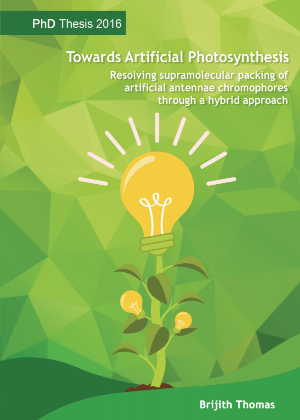Dissertation
Towards artificial photosynthesis: resolving supramolecular packing of artificial antennae chromophores through a hybrid approach
Promotor: H.J.M. de Groot
- Author
- B. Thomas
- Date
- 10 November 2016
- Links
- Thesis in Leiden Repository

Photosynthesis is a highly cross linked process. However, we can distinguish a set of fundamental building blocks like chlorophylls, which interact to form photosystem, which performs the complex function of water splitting. The key challenge in artificial photosynthesis is to learn how to design systems that can adapt and optimize their topologies in line with self-assembly of natural photosystem. In this thesis I combine different techniques of cross polarization Magic angle spinning Nuclear Magnetic Resonance and Transmission Electron Microscopy with simulation and modeling, to resolve the global packing of molecules which are potential candidates for efficient solar fuel cell devices. This thesis focuses on the packing analysis of three-dimensional structures, which are heterogeneous in nature. I demonstrate a new and general structure determination approach that, in combination with first-principles quantum chemical calculations, establishes the structures of molecularly ordered antenna complexes that lack long-range 3D atomic crystalline order. This is possible despite the absence of a priori information on the space group or atomic coordinates. Chapter 2 describes DATZnS(3ʹ-NMe) parallel stacking in an antiparallel framework with the P2/c space group. 13C CP/MAS NMR yields number of asymmetric sites in the structure and recognition motif. This in conjunction with unit cell parameters and diffraction spots from the Fourier transformation of a TEM image is used to resolve the structure. Supramolecular recognition motif is a characteristic of the packing of the DATZnS(3ʹ-NMe) molecule. The molecular recognition and molecular symmetry steer the packing into a racemic mixture with a c-glide plane and inversion symmetry to release the steric hindrance. Simulation of the LGCP build up curve between specific pairs and electron diffraction were used to validate the proposed packing. Chapter 3 describes the centerosymmetric dimer formation with NMI extending outwards to capture the solar energy. MAS NMR chemical shifts were used to generate a truncated 1,7-perylene-3,4,9,10-tetracarboxylic monoimide dibutylester motif. This motif is further optimized and used for molecular replacement approach to generate a partial 3D electron density approach. The P-1 symmetry obtained from Electron Nano Crystallography is used to graft the naphathelene monoimide substituents. The alkyl chains are modeled using the intermolecular correlation observed in HETCOR. Naphthalene monoimide antennas projecting out from the rows of dimers formed out of rod type D1A2 could capture the light energy and transfer to dimers through FRET. Finally, in chapter 4 C2 molecular symmetry obtained from MAS NMR and DFT modeling is used as the core motif to propose the packing of the DATZnS(4H). Intermolecular correlations obtained from the HETCOR shows the folding of the tails along the phenazine moiety. The analogous modeling showed how the packing could be steered by the NCH3 functional group between antiparallel and parallel dipoles. This understanding opens the way for the evidence based design of light harvesting antenna. In summary, a novel methodology to resolve the structure of chromophore antenna from a structural background with static and dynamic heterogeneity that strongly limits the diffraction response is shown. Furthermore, I anticipate that the insights into packing of the antenna are key to the design of the organic solar fuel cell device in the future.
